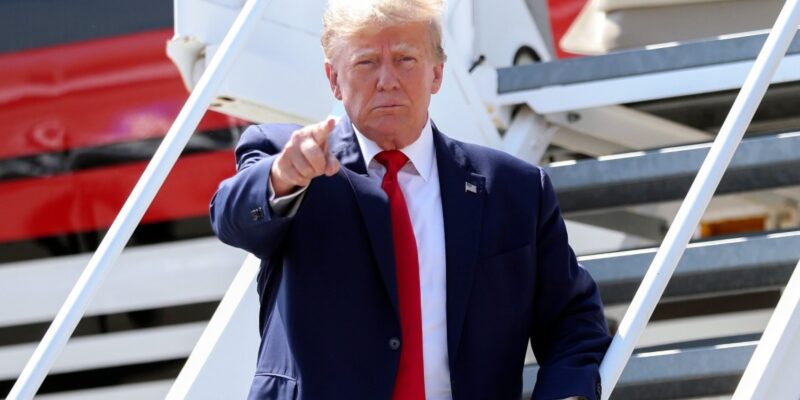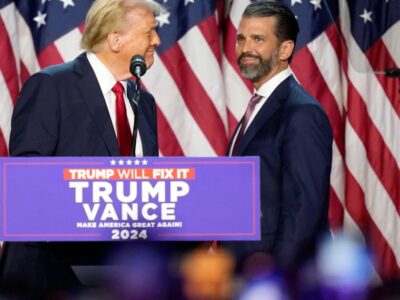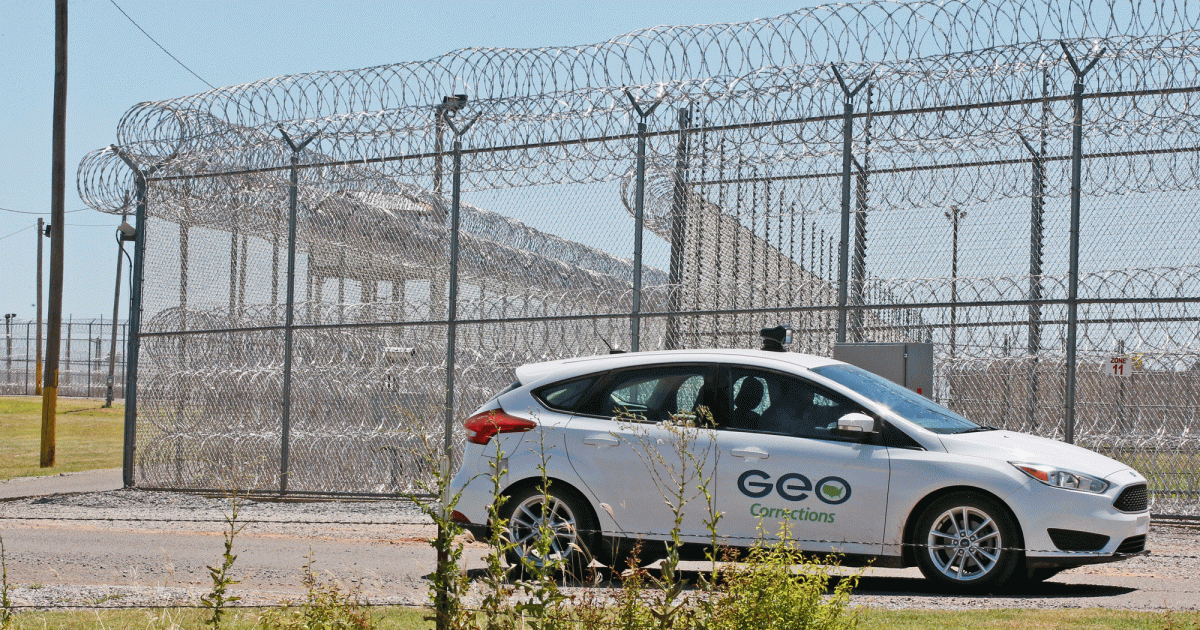
Editor’s note: The below article first appeared in David Corn’s newsletter, Our Land. The newsletter comes out twice a week (most of the time) and provides behind-the-scenes stories and articles about politics, media, and culture. Subscribing costs just $5 a month—but you can sign up for a free 30-day trial of Our Land here. Plus, David Corn’s American Psychosis: A Historical Investigation of How the Republican Party Went Crazy, a New York Times bestseller, has just been released in a new and expanded paperback edition.
If you’re not familiar with term “stochastic terrorism,” now is a good time to bone up, for the leading Republican candidate is a stochastic terrorist.
Stochastic terrorism is defined by conflict and law enforcement experts as the demonization of a foe so that he, she, or they might become targets of violence. Scientific American recently put it this way:
Dehumanizing and vilifying a person or group of people can provoke what scholars and law enforcement officials call stochastic terrorism, in which ideologically driven hate speech increases the likelihood that people will violently and unpredictably attack the targets of vicious claims. At its core, stochastic terrorism exploits one of our strongest and most complicated emotions: disgust.
In addition to disgust, fear and hatred can work, the point being to depict a person or set of people as a loathsome other undeserving of respect or acceptance, and a dangerous threat. Establishing such a framework boosts the odds that a lone individual or group will violently assault the deprecated.
Last year, after the FBI raided Mar-a-Lago, Donald Trump’s Florida residence, in search of stolen classified documents, an Ohio Trump devotee named Ricky Shiffer, wearing tactical gear and armed with an AR-15, tried to breach the FBI field office in Cincinnati. He failed and fled, and later died in a shootout with law enforcement. Noting that far-right Rep. Paul Gosar (R-Ariz.), a leading election denialist, after the raid, had declared, “We must destroy the FBI,” my colleague Mark Follman wrote:
Was Shiffer spurred to attack the FBI by the statements from Trump and Gosar? It’s hard to know, and that’s no accident. Shiffer’s actions point to a rhetorical method experts call “stochastic terrorism,” whereby a leader vilifies a person or group in ways likely to instigate random supporters to attack those targets, while the instigator maintains a veneer of plausible deniability. Trump made this form of incitement a hallmark of his presidency, galvanizing extremists by railing against and dehumanizing his “enemies.” The country saw the devastating consequences when his supporters stormed Congress to obstruct certification of the presidential election.
Of course, there have long been many instances of Trump encouraging political violence. Axios has compiled a list. As has ABC News. And Vox. And the New York Times. Often, it’s been tough-guy bluster, with Trump telling law officers to handle suspects roughly, pledging to shoot looters, or saying to attendees at his rally that it’s okay to beat up protestors. Stochastic terrorism is more indirect and perhaps more effective: It’s pinning a bull’s-eye on the back of an opponent in a volatile situation—perhaps suggesting the world would be safer without this supposed threat—knowing this could lead to violence against that target. It’s indirect incitement, inspiring someone else to do the dirty work.
Trump is a master of this. After all, he got thousands of his cultists to storm the Capitol and try to prevent the congressional certification of his loss to Joe Biden. In recent days, he has fired up his stochastic terrorism machine. For a Rosh Hashanah messaged posted on social media earlier this month, Trump railed against “liberal Jews”: “Just a quick reminder for liberal Jews who voted to destroy America & Israel because you believed in false narratives! Let’s hope you learned from your mistake & make better choices moving forward!”
This holiday greeting came as antisemitism appears to be on the rise, and it certainly carried a menacing tone, suggesting that liberal Jews—who are a majority of Jews—are enemies of the United States. It is not hard to imagine that a deranged person contemplating an attack on a synagogue would read this post as a green light.
Trump was far more explicit in a recent post on Army Gen. Mark Milley, who is about to step down as chair of the Joint Chiefs of Staff. He denounced Milley for the chaotic withdrawal from Afghanistan (an action that Trump had set in motion) and called him a “Woke train wreck.” Trump assailed Milley for talking to his Chinese counterpart in the final turbulent weeks of the Trump presidency (which Milley said he did in coordination with other senior defense officials to assure China that Trump was not planning a surprise attack on China).
Trump called this a “treasonous” step and “an act so egregious that, in times gone by, the punishment would have been DEATH!” Once more, it is not difficult to envision a Trump fanatic seeing this as a call to assassinate Milley. He might as well have exclaimed, “Will no one rid me of this turbulent Milley?” And with Milley a possible witness against Trump in the stolen documents case, this post might also have been an attempt at witness intimidation. (Gosar also implied Milley should be put to death, writing in his weekly newsletter, “In a better society, quislings like the strange sodomy-promoting General Milley would be hung.”
Days later, Trump condemned NBC News and MSNBC—and their corporate owner, Comcast—for committing “Country Threatening Treason” with their critical and “vicious” coverage of him. He threatened to investigate them should he regain the White House. I assume NBC News and MSNBC reviewed their security procedures after this. (Interest declared: I am an MSNBC contributor.)
Accusing a person or entity of treason is essentially saying that they deserve execution. That sends quite the message to Trump’s supporters, especially the unhinged ones. And we already know that they can be a violent bunch and follow his not-so-subtle hints to target his opponents (and to beat up cops).
Trump is hardly alone in deploying this form of terrorism. Last week, billionaire Xer Elon Musk tweeted, “The Soros organization appears to want nothing less than the destruction of western civilization.” Given that billionaire philanthropist George Soros has long been the target of antisemitic attacks, antisemitic conspiracy theories, and at least one assassination attempt, that Musk himself has previously mounted an antisemitic attack on Soros, and that Musk’s X platform has been credibly accused of hosting an increase in antisemitic posts, one might expect Musk to be a bit careful here. But…no. Musk didn’t call for violence to be waged against Soros, yet by characterizing Soros as seeking the “destruction of western civilization,” he hyperbolically presents Soros as an existential threat to the United States and the entire Western world. Now what should one do about such a threat?
As Follman noted, many Republicans have followed Trump’s lead in deploying extreme rhetoric that could spur violence:
After Mar-a-Lago, Trump allies claimed that the feds were coming for the MAGA base next. If the FBI can do this to him, they inveighed on social media and Fox News, just imagine what they could do to you. Ditto with their response to new funding boosting the ranks of the dilapidated IRS. This represents a stark reversal for the GOP: Whereas President George H.W. Bush once renounced the National Rifle Association for disparaging federal agents as “jack-booted thugs,” Republican senators now wield such rhetoric. “Stop Biden’s shadow army of 87,000 IRS agents,” Ted Cruz warned. Chuck Grassley insinuated that an IRS “strike force” could show up with assault weapons “ready to shoot some small business person in Iowa.”
At a rally last year, GOP Gov. Ron DeSantis, who has been trying to out-Trump Trump, said of Dr. Anthony Fauci, “I’m just sick of seeing him. Someone needs to grab that little elf and chuck him across the Potomac.” With much conflict and disagreement still prompted by the Covid pandemic, DeSantis was legitimizing the idea of committing violence against Fauci. The crowd roared with approval.
Trump, Musk, DeSantis, Gosar—they all know they are speaking to or tweeting at people who are angry and riled up. The brush is dry, and they are suggesting where a match should be lit. In August 2022, Follman attended a threat-assessment conference where leaders in the field told him they were deeply alarmed by the tense national atmosphere: “While far-left rhetoric has stirred some violent protests and threats, they said, plots and attacks fueled by Trump’s incitement and MAGA extremism are by far the driving concern.”
With Trump under indictment in four cases—for a variety of allegations, including treasonous actions, stealing classified government documents, and making hush money payoffs to a porn star—and lashing out, threats of violence are increasing. The New York Times summed up recent developments: a woman called the chamber of the judge overseeing the federal election interference case against Trump and said, “We are coming to kill you”; FBI agents are worried about threats to their families; and top prosecutors in the cases require round-the-clock protection. The bottom line: “As the prosecutions of Mr. Trump have accelerated, so too have threats against law enforcement authorities, judges, elected officials and others. The threats, in turn, are prompting protective measures, a legal effort to curb his angry and sometimes incendiary public statements, and renewed concern about the potential for an election campaign in which Mr. Trump has promised ‘retribution’ to produce violence.”
Trump recently visited a gun store in South Carolina, and his campaign posted on X that he had purchased a Glock pistol. With his indictments, it would likely be illegal for the store to sell him a firearm, and the campaign quickly deleted the post, noting that he had admired the gun but not bought it. All this could be read as another violence-triggering signal to his supporters. This store that Trump promoted supplied one of the weapons used in the racist shooting last month at a Dollar General store in Jacksonville, Florida.
Trump and the GOP continue to get away with their encouragement of violence. Why wasn’t his post suggesting Milley be executed major news for a week, provoking controversy and forcing every Republican to respond? The answer is obvious: Trump’s extremism has become fully normalized. It’s Trump being Trump. When he endorses the nutty and dangerous QAnon conspiracy theory, when he says the Constitution should be suspended so he can be reinstated as president, when he dines with a white nationalist and a prominent antisemite—none of this prompts lasting national outrage that transcends the usual tribal partisan politics.
Then again, why should it? Trump has done worse. He has (so far) gotten away both with trying to mount a coup and with inciting a violent riot that he hoped to exploit to stay in power—at least insofar as he’s the odds-on favorite to snag the Republican nomination. And despite all that, he’s often treated by much of the mainstream media as a politician, not a peril. Yet for the security of American democracy, Trump needs to be widely seen for what he is: this stochastic terrorist. The more he vilifies his detractors, the more he assaults the justice system, the more likely there will be more violence. He knows this, and that is the point.















